Solar system formation
In recent years, we have seen huge advances in both observation and theory of solar system formation. Increased telescope resolution has allowed us to begin to see extrasolar systems in various stages of evolution.
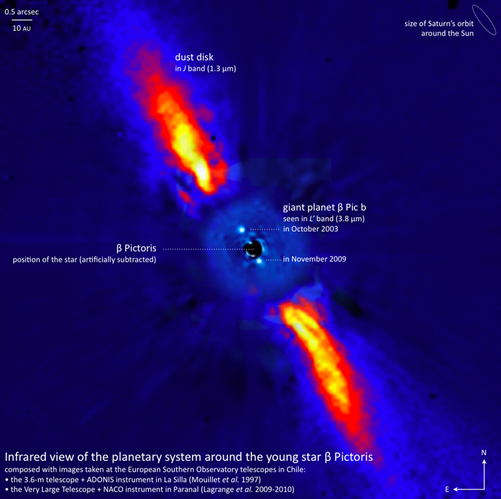
The above image of was taken by the Very Large Telescope at the European Southern Observatory and shows the debris disk surrounding the young star, Beta Pictoris, complete with a visual image of a gas giant planet orbiting the star. Also increased computational speed and power has allowed us to model systems at much higher resolution than before, and include more detailed physics in our models.
Our own solar system offers us our best, closest model for understanding how the constituent parts shed light on how the system must have formed. However, since the discovery of extrasolar planets in 1988, we have found over a thousand multiple planet systems. Our theory about how solar systems formed now needs to work for these other systems as well.
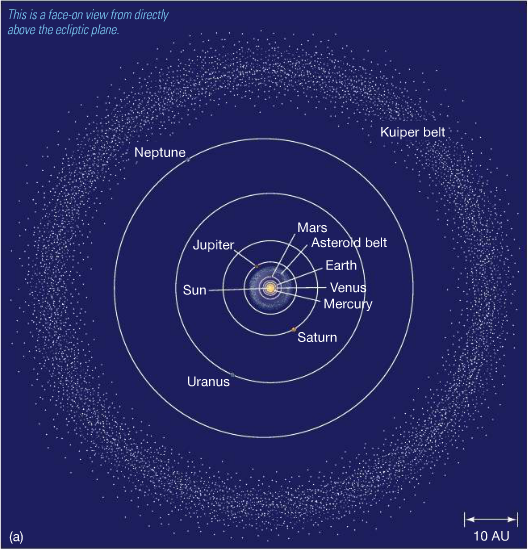
Model requirements
Our own Solar system consists of a central star with several planets. There are also comets and an asteroid belt, not shown in the animation. Based on what we observe in our solar system, our theory of its formation needs a few key ingredients.
- Planets are relatively isolated in space
- Planet orbits are nearly circular
- Planet orbits roughly lie in the same plane
- Orbits of the planets and their moons are generally in the same sense as the rotation of the sun
- Rotation of the planets and their moons are generally in the same sense as the rotation of the sun
-
We see two kinds of planets
- small rocky terrestrial planets
- gas giants
- Asteroid belt between the terrestrial planets and gas giants
- Belt of icy objects beyond the gas giant planets
- Cloud of icy objects beyond the belt of icy objects
Any model we construct must explain these characteristics. The fact that the sense of rotation seems to be the same, in general, for the bodies in the solar system suggests that it was formed from one large, rotating cloud. This theory is called the "solar nebula" theory. As the nebula contracted under the pull of the gravitational force, its rotation tended to flatten it into a disk of material.
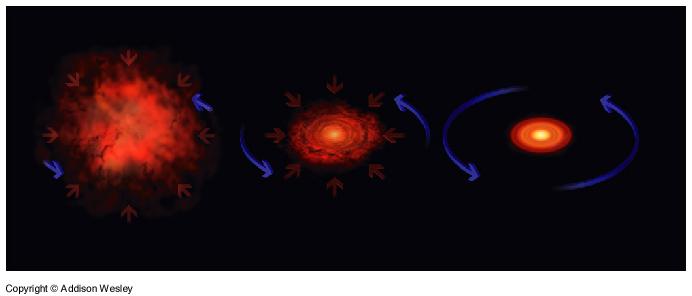
One of the open questions in the theory concerns how so much of the matter of the disk ended up in the star. There should have been only a few percent of the material lying over its rotational axis, yet in our solar system, the sun contains about 99% of the mass.
Temperature effects
To answer the question of why there are two kinds of planets, terrestrial planets and gas giants, we need to consider the temperature of the protoplanetary disk. The disk would be considerably hotter in the inner region.
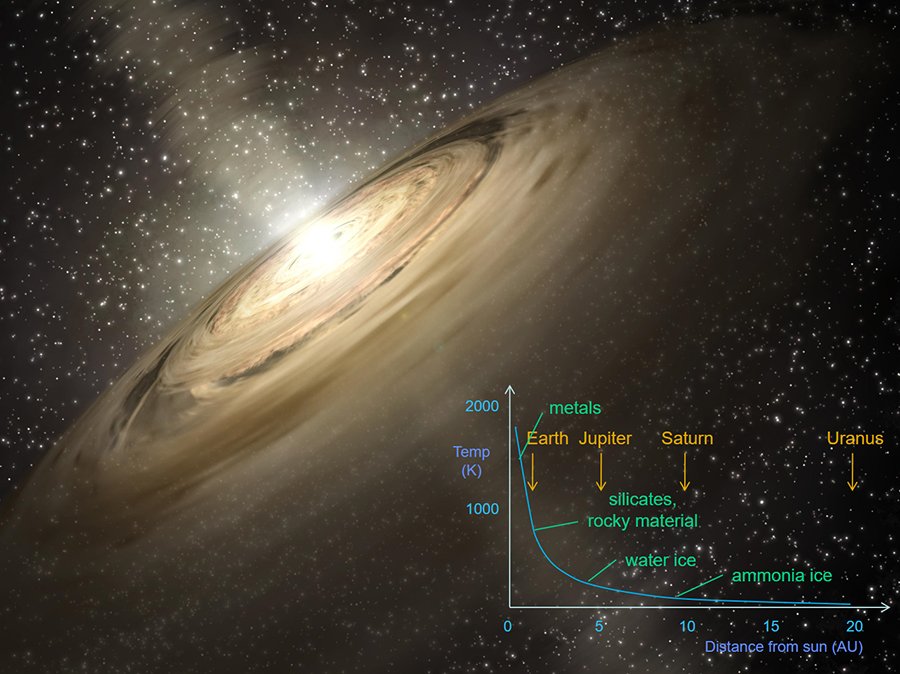
This illustration includes a plot of the temperature of the protoplanetary disk with respect to distance in astronomical units (AU). An astronomical unit is defined as the distance between the sun and earth. Notice that the temperature is very high at 1 AU but the curve falls off rapidly by the time it gets to Jupiter.
In the inner region where the terrestrial planets formed, the temperature would allow metals and rocky materials like silicates to condense, but it would be far too hot for materials like water and ammonia to condense. Farther out in the disk where the temperature was lower, the volatile materials could condense. This is much like what we call the "snow line" on earth. Often times, it is warm enough to rain in the valleys but cold enough to snow above a certain elevation. Astronomers also use the term "snow line" to describe the distance outward from the center of the protoplanetary disk where the temperature dropped low enough for the ices to form.
Core accretion theory
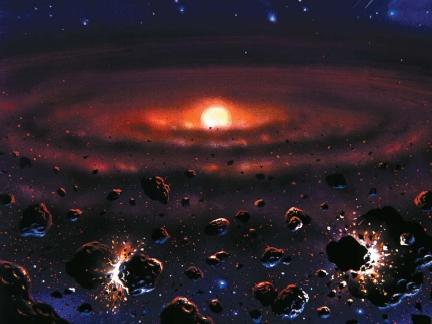
Core accretion thoery is simple in concept. Small granules collide and stick together via the electromagnetic force, eventually increasing in size and mass to form protoplanet cores. Once the core gets massive enough, it begins to gravitationally attract dust and gas from the surrounding material to grow even more. The process stops when fusion begins in the new star. Then, strong stellar winds sweep out dust and gas from the disk, leaving behind only the more massive chunks of material. Until recently, there has been a problem with the core accretion theory, that it would take far too long for a planet to form in this way. Recent advancements in modeling include more physical aspects, like the accretion of small pebbles onto the core (Lambrechts 2012), reducing the formation time.
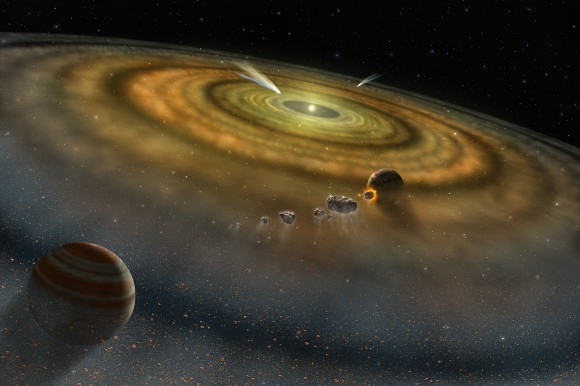
credit: NASA/FUSE/Lynette Cook
Gravitational instability theory
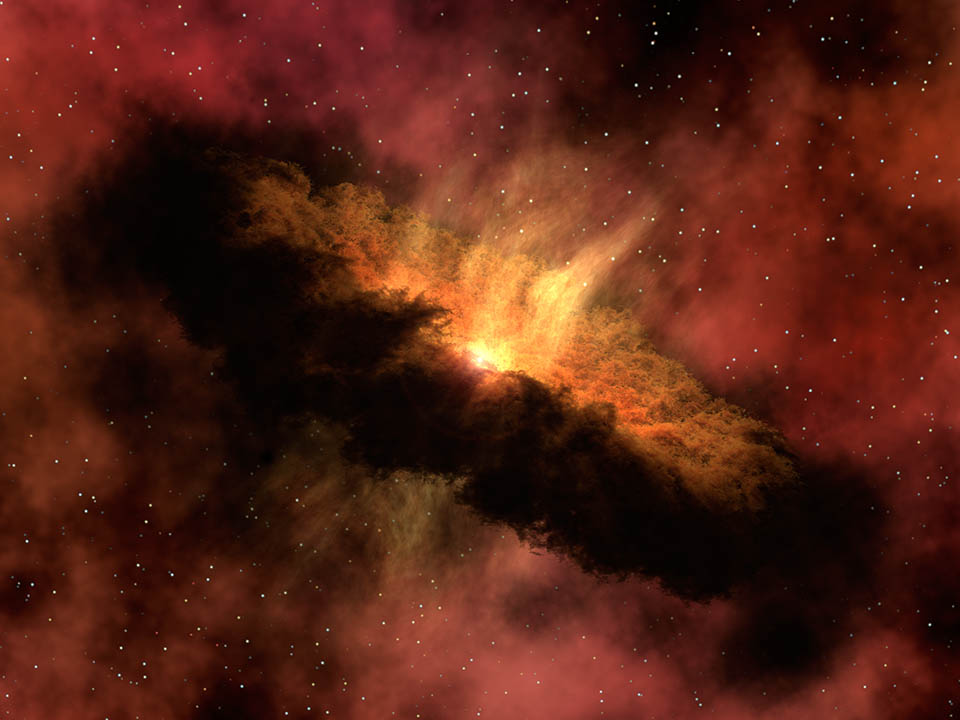
Gravitational instability theory involves waves that sweep around the protoplanetary disk, much like the compression waves that cause the formation of spiral arms in galaxies. The geometry of the disk tends to support characteristic waves, similar to standing waves.
We can start to build an understanding of this mechanism by considering a wave on a string. This interactive PHet simulation allows us to investigate a simple wave on a string. With a bit of practice, you can produce a standing wave on the string.
We can visualize standing waves to get an idea of how this works (animation courtesy of Dr. Dan Russell, Grad. Prog. Acoustics, Penn State). A standing wave is produced when two identical waves pass through each other. It is called a standing wave because it appears to stand still. The points that lie along the center line don't appear to move.
This drumhead simulation (animation courtesy of Dr. Dan Russell, Grad. Prog. Acoustics, Penn State) demonstrates how a two dimensional standing wave can be supported on a membrane.
This Chiladni plate demonstration shows how even more complicated standing wave structures can be supported by a plate. Notice how the standing wave pattern depends on the shape of the boundaries of the plate. Now imagine a similar system, with characteristic waves, but the system in this case is a huge disk of dust and gas, held together by gravity and supported by pressure, rotating differentially (at different speeds for different radii).
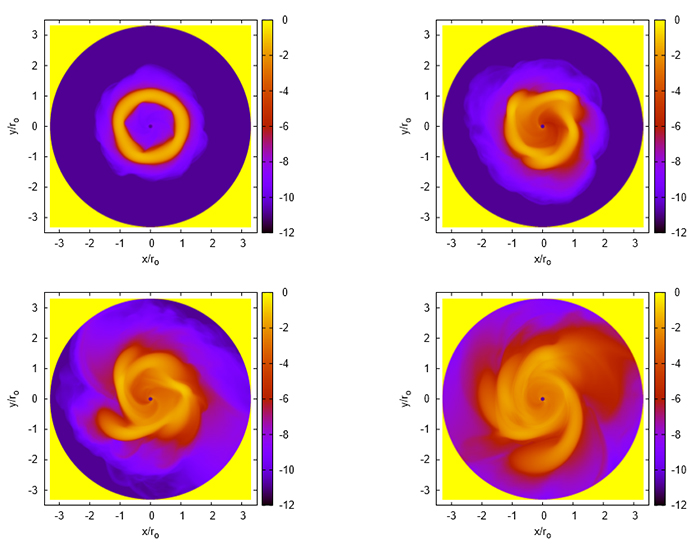
This set of images shows the evolution of a model of a protoplanetary disk, simulated on a computer. The waves are driven by a gravitational instability in the disk. The simulation was created using basic conservation laws of physics.
This gravitational instability simulation in a star-disk system shows an initially stable disk driven unstable by the interplay of gravitational force, pressure, and rotation. This model has a very high rate of cooling, so is not realistic, but it does illustrate clumping in the disk. In the gravitational instability theory, these clumps could contract to directly form planet cores from disk matter. Gravitational instability also provides a means to transport matter inward from the disk to the star.
Vortex instabilities are another kind of instability that may prove insightful. They are cyclones and anticyclones that can form in a disk, much like hurricanes form in our atmosphere. Two streams of fluid moving next to each other can form swirls, as seen in this jet simulation.
General theory

© 2005 Pearson Prentice Hall, Inc.
Solar system formation timeframe
To recap, solar system formation begins with a collapsing fragment of a giant molecular cloud. The fragment spins up as it collapses under gravity and flattens into a differentially rotating disk of dust and gas. Temperature differences cause condensation of metals in the inner disk, while ices are able to condense in colder outer regions of the disk. In the core accretion scenario, dust grains accrete into planetesimals which grow into planet cores. Gas giant planet cores grow large enough to gravitationally attract gas from the surrounding disk. In the gravitational instability scenario, clumps of gas form in the disk to form protoplanets. Dust grains sink to the center of the protoplanets to form cores. In either case, when fusion begins in the star, stellar wind blows away dust and gas, leaving protoplanets. Protoplanets continue to collide and form larger bodies until a relatively small number of planets remain in the solar system. Minor planets like Pluto, and comets, reside in the outer part of the system.
This animation illustrates the formation of a young system, beginning with a disk of dust and gas, resulting in a system with a star and newly formed planets.
Observation
The formation of a solar system takes millions of years to occur. We cannot hope to gain understanding about the process by watching one form in real time. We can, however, look for evidence of many solar systems in various stages of formation in our galaxy. Our technology is beginning to be able to see such systems.
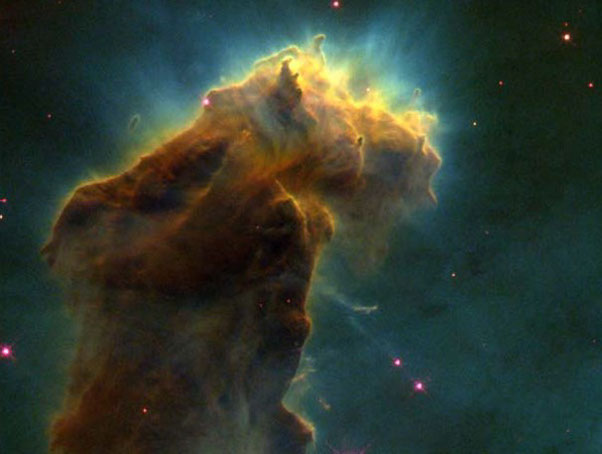
This closeup of the Eagle nebula taken by the Hubble Space Telescope shows a cluster of stars being formed. Stellar winds have sculpted the dust and gas in the nebula, leaving behind the densest material to begin collapsing under the force of gravity.
This animation from Hubble telescope scientists shows what it might look like to fly through a star-formation region like the Orion nebula. The forming stars here are still shrouded by cocoons of dust and gas called proplids. Inside these proplids can be seen newly formed stars surrounded by disks of material.
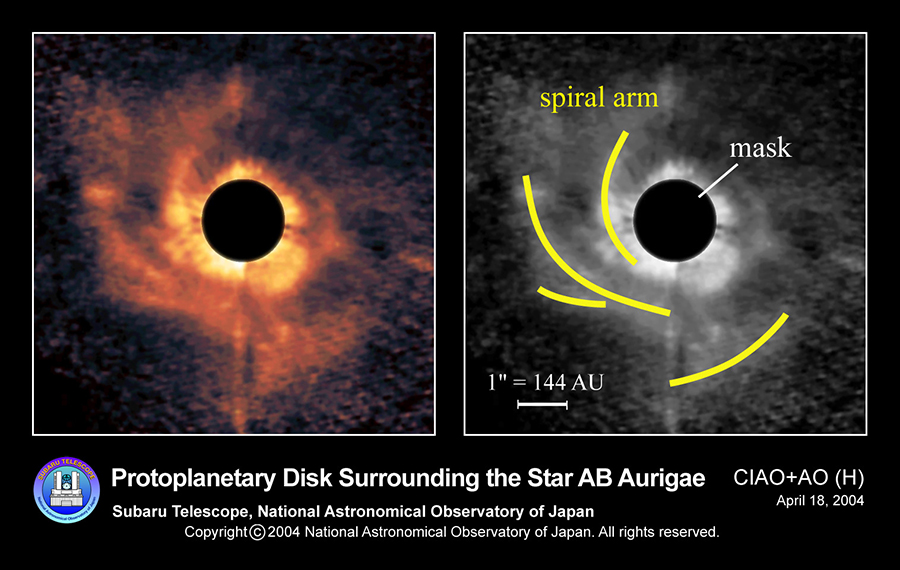
This image taken by the Subaru telescope shows AB Aurigae, a protostellar system with a disk exhibiting spiral arms. The star has been masked in these images so that its brightness does not overpower the image. Many observations of circumstellar disks have been made, cataloged at this website.
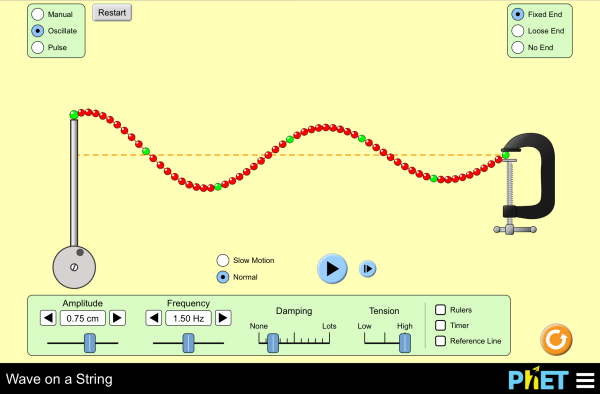
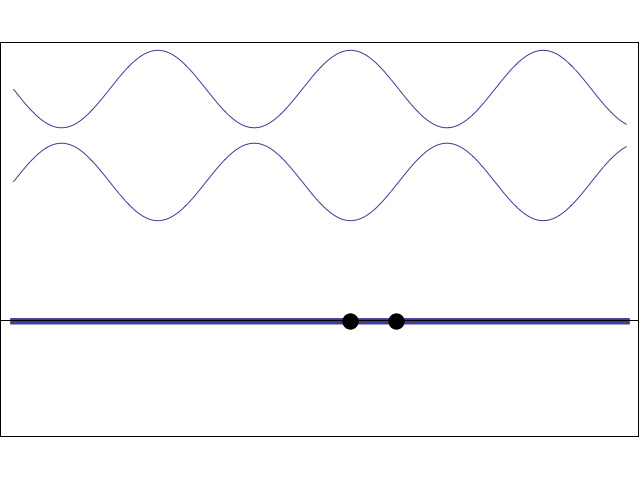



© 2005 Pearson Prentice Hall, Inc.